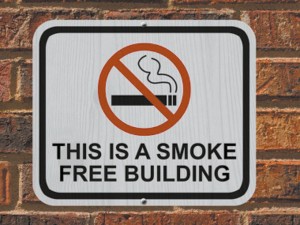New Orleans’ public housing will be smoke-free by third-quarter 2018
19th December 2016 · 0 Comments
By Susan Buchanan
Contributing Writer
Smoking has been restricted for awhile by public housing authorities in San Antonio, Houston, Seattle, Detroit, Boston and other cities. In August 2018, a nationwide ban inside PHA residences, announced by the U.S. Housing and Urban Development in late November, goes into effect. The Housing Authority of New Orleans and managers of the city’s public complexes are getting ready for smokers to head outside.
“We have lots of questions about how these restrictions will work for our residents,” Cynthia Wiggins, president of Guste Homes Resident Management Corporation in Central City, said last week. “We’re told that you’ll have to be 25 feet from a building to smoke.” That could be awful on a rainy or frigid day in New Orleans. And at any given time, what are physically homebound smokers meant to do?
“For some of our residents, smoking appears to be an addiction,” Wiggins said. “Will it be considered a disability for them, and will they receive treatment or other assistance?” GHRMC, which runs the Guste Homes complex under a contract with the Housing Authority of New Orleans, provides health and wellness services and health fairs for residents.
In a conference call after HUD Secretary Julian Castro’s Nov. 30 announcement about the new restrictions, “there were so many participants on the phone from around the country that we weren’t able to ask our questions,” Wiggins said.
HUD’s final rule will prohibit lit cigarettes, cigars and pipes in living units, common areas and offices within 25 feet of residential and administrative buildings, Castro said in late November. HUD received over a thousand comments about the rule, which has been a year in the making, from housing authorities, health groups and tenants’ advocates.
Breaches of the smoke-free policy will be considered lease violations, HUD said. But the agency isn’t looking to have residents evicted, and it will discourage over-enforcement that could make people homeless. What’s more, housing authorities will be allowed to sign new leases with smokers.
“Since HUD’s directive regarding smoke-free public housing was issued, the Housing Authority of New Orleans is in the early stages of developing a policy to address the matter,” Gregg Fortner, HANO’s executive director, said last week. HANO intends to fully comply with the rule.
The new policy is expected to start 18 months after the Feb. 3 effective date of HUD’s rule, or in August 2018.
People commenting on the rule raised concerns about outdoor smokers being vulnerable to crime and about parents leaving small children alone while they go outside. HUD’s response was that it encourages housing authorities to provide a safe environment for all residents.
What’s a smoker who’s in a wheelchair or confined to a sofa to do? According to HUD, the Rehabilitation Act of 1973, the Fair Housing Act, and the Americans with Disabilities Act give public housing residents, including those with mobility problems, the right to reasonable help with restrictions. HUD reviewed information from commentators and national surveys indicating that people tend to smoke more if they’re disabled. Accommodations requested by residents must be considered, HUD said in its rule, and may be granted as long as they don’t unduly burden a housing authority.
“A PHA may consider flexibilities, such as moving a resident to a first-floor unit to provide easier access to smoking outside, or modifying a walkway with additional lighting for easier use by that resident,” HUD said in its final rule.
“Communities will have to make decisions about how HUD’s new restrictions are implemented, and their decisions will be key to the success of the smoke-free policy,” Erika Sward, assistant vice president with the American Lung Association in Washington, DC, said last week.
Leaning out of windows with cigarettes and lighting up on balconies won’t be allowed. “Some PHAs may decide to construct designated smoking areas, or DSAs, and at their discretion these could include conveniences, such as seating and heat sources,” HUD spokeswoman Patricia Campbell in Fort Worth said. “Designated areas will have to be at least 25 feet away from public housing buildings.” While housing authorities don’t have to build designated areas, HUD asks them to work with residents on outdoor needs.
“Smoking isn’t a disability, but it is an addiction,” Sward said. “HUD’s new rule won’t ban smoking; it just takes it outside.” Seventy percent of smokers nationally say they want to quit, however, she said, and depending on how they get their medical care, public health and clinical solutions exist. “For instance, if someone is 65 or older, Medicare covers a host of decision-based options to quit smoking,” she said.
In the last seven years, HUD has encouraged housing authorities to adopt smoke-free policies, and since then more than 600 PHAs and Tribally Designated Housing Entities have done so. Today more than 228,000 public housing units are smoke-free. When fully implemented, the smoke-free rule will cover over 940,000 units nationally, more than half of which are occupied by seniors. The rule will apply to 760,000 children by August 2018.
How does smoke get into an apartment inhabited by nonsmokers? “It doesn’t stop at doorways, but goes through cracks, along electrical and plumbing conduits and through air vents,” Jonathan Winickoff, a Massachusetts pediatrician and Harvard Medical School assistant professor, said last week. “Air in a large apartment building becomes contaminated when a single cigarette is smoked inside.” In multi-unit housing across the nation, unwanted smoke is the top complaint made by residents. “And it isn’t just parents of children doing the complaining,” Winickoff said. “Over 80 percent of adults now are nonsmokers. They don’t like to smell toxic chemicals from other people’s cigarettes.”
In its final rule, HUD said: “Time spent by PHA staff on implementing and enforcing the smoke-free policy will be partially offset by the time that staff no longer spend mediating disputes among residents over second-hand smoke infiltration.”
According to the CDC, cigarette smoking is the leading, preventable cause of death in the United States, killing 480,000 Americans a year. Nationally, incidents of lung cancer vary by ethnic group. “African Americans have the highest lung-cancer rates, while Latinos have the lowest,” Allison MacMunn, American Lung Association spokeswoman, said last week. Rates for whites, Asian Americans and Native Americans fall between those two groups. Lung cancer strikes 65 out of 100,000 African Americans yearly and afflicts 58.8 of 100,000 whites.
As for asthma, “rates are higher among African Americans and lower among Latinos overall,” MacMunn said. “And among Latinos, Puerto Ricans have the highest asthma rates.”
Along with smoking’s dangers, U.S. Surgeon General Vivek Murthy last month warned about second-hand smoke. “For children exposed to it, second-hand smoke can mean everything from Sudden Infant Death Syndrome and ear infections to asthma,” he said.
Smoking is the major cause of fire-related deaths in multi-family buildings, and banning it indoors will reduce casualties in public housing, according to HUD. Another benefit of going smoke-free is lower maintenance expenses in buildings. When rental units change hands, painting and carpet cleaning costs are less in non-smoking dwellings.
In addition to restrictions on low-income public units, smoking will not be permitted in any mixed-income, public housing once the new policy is implemented, HUD’s Campbell said. “But the smoke-free policy won’t apply to other government assisted housing, such as Section 8 project-based and tenant-based rental assistance,” she said.
HUD is liaising with the Centers for Disease Control and Prevention, the American Cancer Society, the American Lung Association and the Environmental Protection Agency to support housing authorities as they become smoke free. The CDC has coordinated with state tobacco-control programs, and is developing materials about smoking-cessation services. Currently, all residents have access to 1-800-QUIT-NOW, connecting callers to state quit-lines.
Self-reported smoking by American adults peaked in 1954 at 45 percent. The U.S. Surgeon General alerted the public to the dangers of smoking in 1964, Sward of the American Lung Association noted. But the practice among adults held at 40 percent or more through the early 1970s. In 1990, 25.5 percent of the nation’s adults smoked, falling to 15 percent last year, according to the CDC.
This article originally published in the December 19, 2016 print edition of The Louisiana Weekly newspaper.



